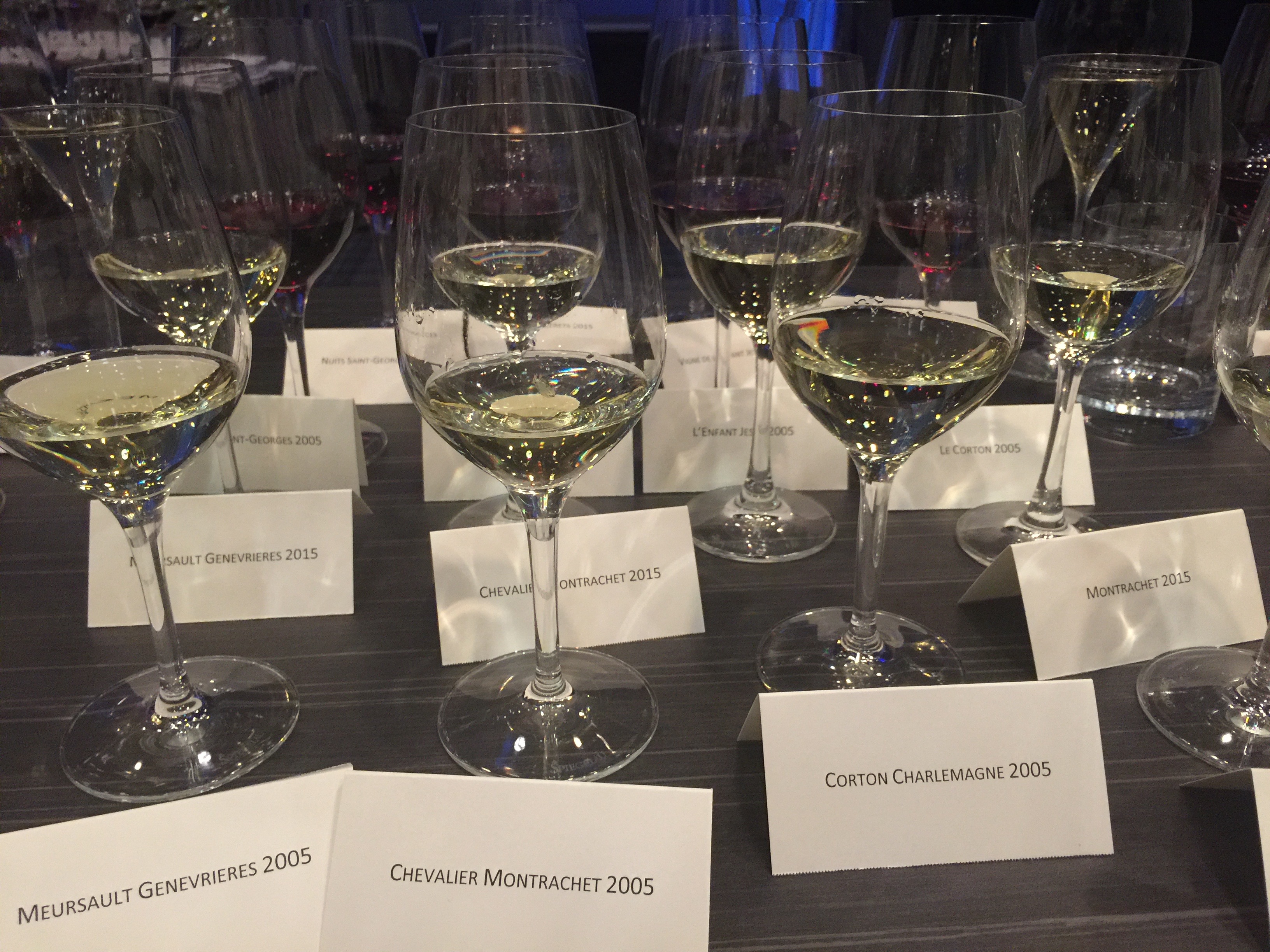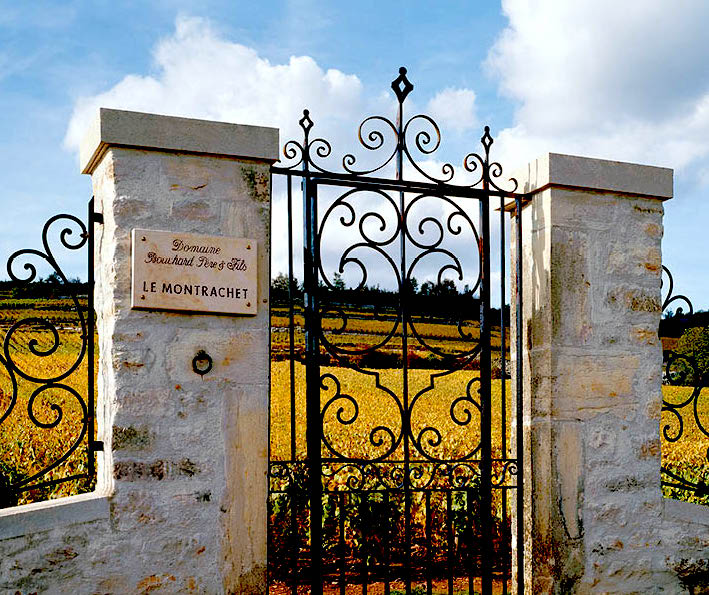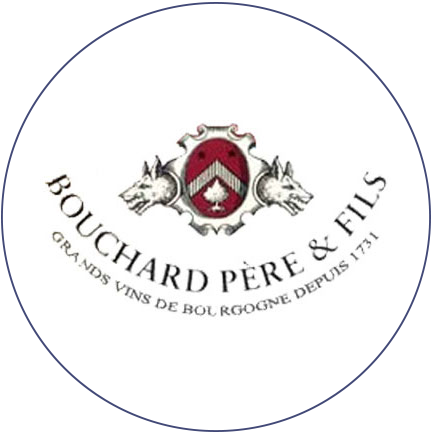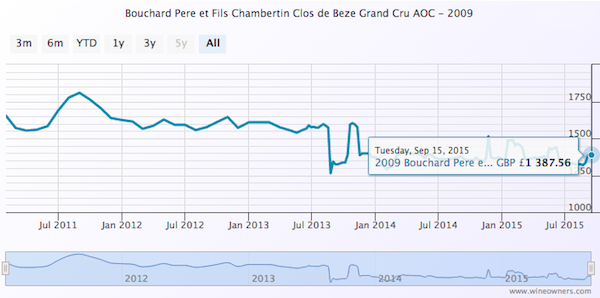by Wine Owners
Posted on 2018-10-22
Omar Khan’s Business & Wine events are hedonistic epics of wine indulgence and learning, and October 2018’s event at The Four Seasons on Park Lane was no exception.
Bouchard’s 2005s are a stunning set of wines, and when compared with 2015 showed fabulous balance and freshness. A beautiful menu that proved a perfect foil to the great wines served including Chevalier Montrachet La Cabotte 2002 and Beaune Greves La Vigne L’Enfant Jesus 1976 demonstrated how unfair Michelin can be in its treatment of hotel establishments compared with independent restaurants: Romuald Feger deserves a couple of stars!
By the time Henriot bought Bouchard Pere et Fils in 1995, the venerable House, founded in 1731 had found itself in a bit of a financial squeeze. New oak barrels were rationed and the wine maker was making do.
Herriot’s purchase changed all of that, and by 2005 Bouchard was well and truly reestablished as one of the great Burgundy Houses, and a microcosm of Burgundy itself with vineyard holdings representative of practically every commune across the Cote de Beaune and Cote de Nuits. The responsibility of this unique heritage is keenly understood by Henriot: so that for consumers discovering Burgundy, whose initial enthusiasm can so easily be diverted by an underwhelming experience, Bouchard Pere et Fils offer a swathe of benchmark wines.

Tasting a cross section of the 2005 Burgundies compared with the 2015 vintage highlighted a number of exceptional terroirs. It also showcased the very high quality of the 2005 vintage. It may well be that 2015 was a much more successful version of 2009, with the warmth of the vintage kept fresh and with retained definition of fruit thanks to more controlled wine making, but on this showing the wines are less precise and less fresh than 2005. Maybe they just need more time; sometimes the intrinsic balance of a wine changes shape over the course of the early years in bottle. Let’s hope that’s the case with these 2015s because the whites in particular need to freshen up.
A little more on the 2005 vintage chez Bouchard. These are, in a word, brilliant. We suspect most Burgundy-philes have resisted broaching their 2005s for fear of encountering a tannic behemoth, such are the tales of untamed structure in the top wines. This range tells a very different story: of freshness; blood orange mid palates, confit fruit illuminated with beaded acidity, and the sort of drive and energy that makes you want to dribble into your poulet de bresse aux tropettes de morts. Of course there’s structure too, but it’s balanced, provides focus and is more than offset by oodles of rich juicy fruit.
Ot the reds L’Enfant Jesus showed the precision of the Beaune Greves vineyard, with a bright thrust of energy, resonance and depth, and a mid palate veined with blood orange and black chocolate. This is a wine for the ages.
Le ‘Le Corton’ is a great red terroir, produced from a vineyard which is also permitted for white Corton. This 2005 doesn’t have the earthy depths of a Bressandes, but exhibits great drive, energy, a concentrated confit mid-plate and is very elegant. A more delicately formed Corton and in my view all the better for it.
Volnay Caillerets 2005 is a more forward wine, although the term is relative in context of the preceding wines. Aromatically spiced with a dark liquorice sweetened mid palate that has a creamy texture, a good sense of energy with oranges present on the finish.
On the night the Chevalier Montrachet 2005 was chalky and mineral, insinuating in its attack before gradually but determinedly building intensity. Very, very long. Le Montrachet 2005 was a powerhouse but so, so primary; a tough one to judge other than elementally and so to try to anticipate something extraordinary in the coming decades.
On this showing, other than recommending you fill your boots with Bouchard 2005s, you might want to check if 2005 Burgundies are well enough represented in your cellar. If not, they’re not going to get any cheaper as they get closed to the start of their drinking windows, so now’s as good a time as any to start looking for some.
by Wine Owners
Posted on 2017-01-06
With the highly touted 2015 Burgundy campaign upon us, we can be sure of two things: it is a superb vintage, and prices will rise.
Let’s be honest, Burgundy is for wine lovers. Although we may have more Bordeaux in our cellars - steady, consistent, blended excellence - it is fickle, flirtatious Burgundy which steals our hearts. And the whole world is now falling in love with Burgundy, courting the tiny quantities and ready to take our place in the queue.
The pure, ripe fruit of the 2015s will tempt early drinking, but if we want to experience the extraordinary range of flavours, textures and sensations that fine burgundy can produce, we must be prepared to wait. Or to seek out mature wines from great producers in other vintages. Remember, in Burgundy more than anywhere, it is the producer who matters more than First floor or the year.
So rather than bet the whole house on the latest vintage, now might be the time to review the Burgundies that your fellow collectors have offered for sale on the fine wine exchange.
There is a dazzling range of beautiful wines available, from the most humble appellations to the greatest of Grand Crus. Some are for drinking now, others for keeping for the future, whatever that may bring. Some are in bond and some are duty paid, but DP prices are never more than their In Bond case equivalents and there is no VAT for exchange buyers. All were bought when the pound was much stronger and prices were lower. Prices of Burgundy’s back vintages may never be this low again.

So where would you start?
Chardonnay is arguably easier to enjoy across the board in youth than Pinot Noir. 2014 whites have greater precision and zest than their 2015 counterparts and it is probably the best vintage since 2001. 2014s are only just starting to appear as offers for sale on the secondary market and they are unquestionably worth having in any cellar.
As long as yields of this naturally exuberant varietal are constrained, there is plenty to pick from: 2013, 2012, 2010, 2007 were all very good, whilst there are some terrific 2006s with nerve and energy, in contrast to lush and giving 2008s. Very late malolactic fermentations in 2001 lent plenty of substance to the best wines; they had longer to feed off their nourishing lees. When looking at 2005 and earlier fears of premature oxidation (premox) have really hurt the market. But there are still old bones that are simply thrilling.
Looking to red Burgundy, consider 2005 - considered one of the great vintages and should make fine old bones, but there's tannins aplenty, some more puckering than others depending on extraction, that suggests another 10-20 years will be required. Indeed they may be drinking in the same window as 2015 or later!
Consider 2010, a vintage with the nerve and intensity of 2008 married to the flesh of a vintage like 1995.
If you want to buy into a vintage that was overlooked when released but that has evolved into one of the most exciting we’ve tasted look to 2002, a lesson if ever there was one in how pinot noir loves luminosity more than heat. These are wines with fine intensity and great purity.
Talking of which, if you’re a classicist and enjoy form over flattery, 2001 is starting to climb the upward slope of maturity with wines that are sappy and crystalline but may have yet to reach their peaks.
The truly great 1999s are lusciously fleshy, sweetly spiced and dense, but at the same time so coiled, that most Grand Crus will surely need another 5-10 years. Many premier crus and village wine are gorgeous now.
2012 is a successful recent vintage that had really low yields (a very good thing for Pinot Noir) but will be cheaper than 2015. Producers love 2012 thanks to their fabulous balance and flattering ripe fruit, which nonetheless blankets an underlying structure for mid term appreciation.
The top tips for 2015s (whatever we say, we know you’ll want to buy some!) are that the lesser appellations, cooler climates and colder soils will excel. You don't need to stretch to the top of the tree to find great Pinot Noir in 2015 to drink over the next 15 years, which is great news for Burgundy lovers and something to be thankful for in a very expensive vintage.
Buying back vintages vs new releases
Other than exceptionally hard to find Grand Crus and Holy Grail producers’ best wines – that you’re either allocated or you’re not – it’s worth looking to premier crus from producers with good reputations for quality and value-hunting.
Take Beaune Grèves L’Enfant Jésus from Bouchard Père et Fils. Whilst back vintages were much cheaper at release than they are today, there isn’t much between the release price of 2015 or any number of superb back vintages.
As the chart below shows, the superb 1999 vintage is still cheaper today than the release price of 2015, the equally acclaimed 2010 is the same price, but you can drink it in 10 years instead of having to wait until the 2030s for the 2015; and only the 2005 and 2002 are a little more expensive – but not hideously so.
by Wine Owners
Posted on 2015-09-15
 OWNER
OWNER
Bouchard Pere et Fils
APPELLATION
Chambertin Clos de Beze
BLEND
Pinot Noir
AVERAGE SCORE
96/100
CRITICS REVIEW
'A strikingly spiced and highly perfumed nose of ripe yet cool red berry fruit, wet stone, underbrush and a hint of animale merges gracefully into highly complex and gorgeously intense flavors that also brim with minerality and plenty of extract on the palate staining and stunningly long finish. This has the potential to be great in time but note carefully that it will need an ample amount of it to arrive at its full potential.'
Burghound
PRODUCER PROFILE
Founded in 1731 in Beaune by Michel Bouchard, Bouchard Père & Fils, is one of the oldest wine estates in Burgundy, perpetuating tradition for over 280 years and 9 generations. It is now the biggest domaine in the Côte d’Or, with 130 hectares of vines, of which 12 are classed Grand Cru and 74 classed as Premier Cru.
(Source: www.bouchard-pereetfils.com)
MARKET PRICE


